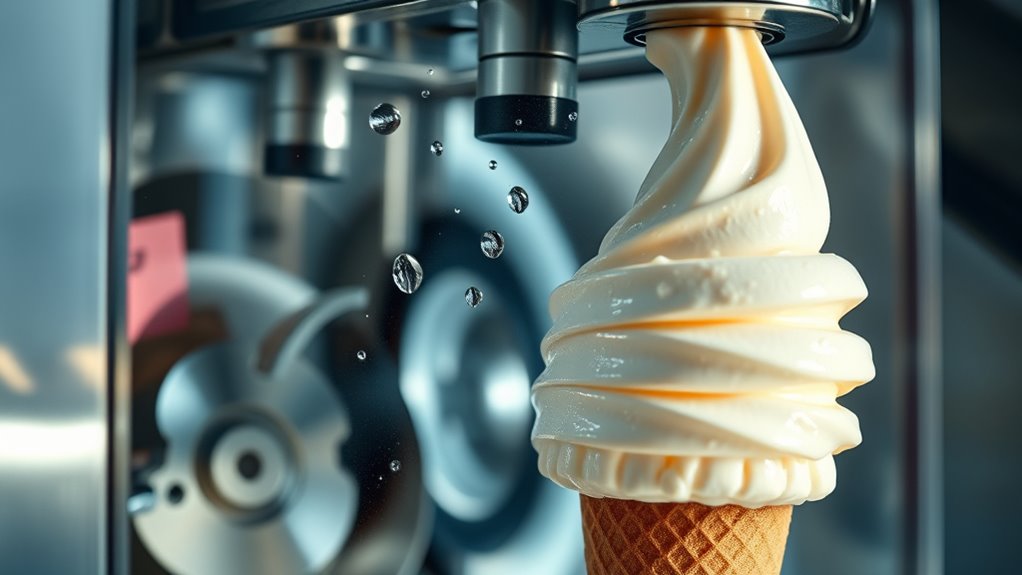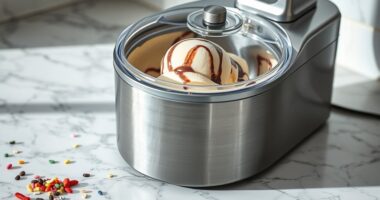The science behind ice cream machines reveals how precise control of ingredients, temperature, and mechanical processes creates that smooth, creamy texture you love. It all starts with carefully managed freezing, where fats and sugars influence crystal size, and agitation introduces air for fluffiness. Mechanical components like paddles and gear mechanisms guarantee consistent mixing and churning. Keep exploring, and you’ll uncover the fascinating secrets that turn simple ingredients into perfection every time.
Key Takeaways
- Ice cream machines control temperature and agitation to regulate ice crystal formation, ensuring a smooth, velvety texture.
- Precise churning incorporates air bubbles, creating a light, creamy consistency while stabilizing foam structure.
- Temperature management influences nucleation and ice crystal size, preventing grittiness and enhancing overall quality.
- Modern innovations like rapid freezing and nucleating agents improve texture, flavor infusion, and production efficiency.
- Mechanical components such as motors and gears drive paddles that mix ingredients, incorporate air, and maintain consistent texture.
The Chemistry of Freezing: How Ingredients Transform Into Ice Cream
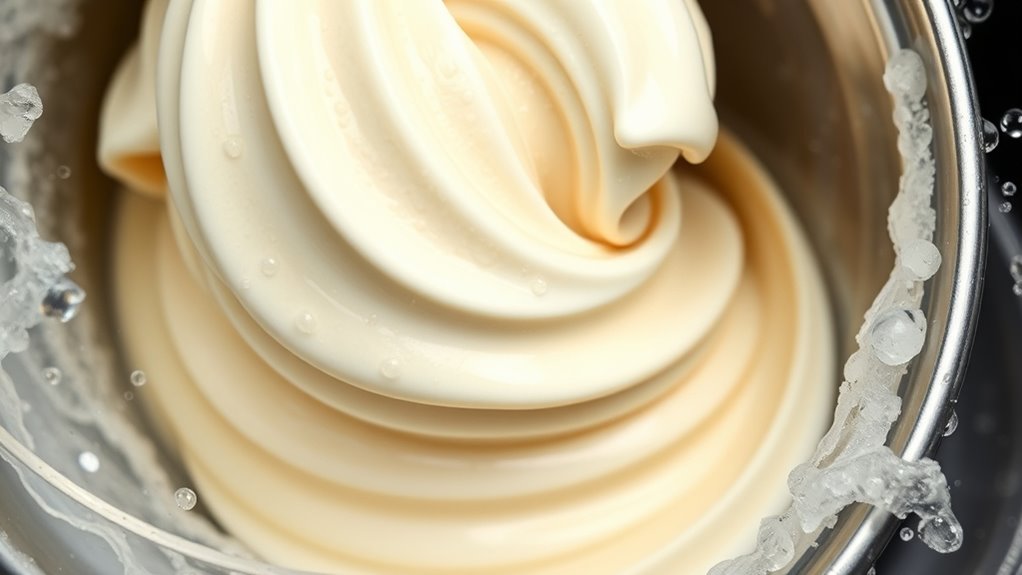
Understanding how ingredients turn into ice cream begins with the science of freezing. When you combine milk, sugar, and flavorings, the temperature drops, causing water to form ice crystals. During this process, flavor extraction happens as the cold helps dissolve and lock in the flavors, ensuring each bite is rich and balanced. Proper packaging techniques are essential in preserving freshness; airtight containers prevent ice crystal growth and flavor loss. As the mixture freezes, the ingredients’ chemistry shifts—sugar lowers the freezing point, and fats create a smooth texture. This transformation relies on controlling temperature and environment, so the ice cream maintains its flavor integrity and quality from production to your spoon. Understanding these processes helps explain how simple ingredients become the delicious treat you enjoy.
The Churning Process: Creating Texture and Consistency
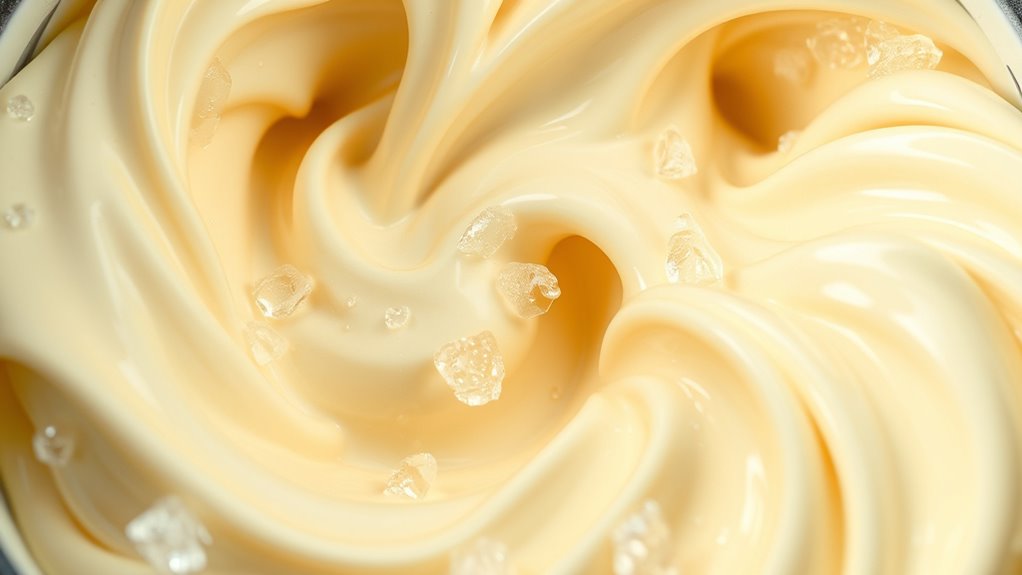
As you churn ice cream, the air incorporation technique helps create a light, smooth texture. Balancing fat and sugar levels is vital for achieving the desired creaminess and structure. Factors like freezing speed and agitation influence the final texture and consistency you experience. Additionally, controlling the congealing process ensures uniform solidification and optimal mouthfeel.
Air Incorporation Technique
Have you ever wondered how ice cream achieves its creamy, airy texture? The secret lies in the air incorporation technique during churning. By introducing tiny air bubbles, the machine promotes foam formation, giving ice cream its lightness. This process involves carefully blending air into the mixture, which increases volume and creates a smooth, fluffy consistency. Proper air infusion ensures a stable foam structure, preventing the ice cream from becoming too dense or icy. The key is balancing air and ingredients to maintain texture without compromising flavor. This delicate process transforms liquid mixtures into a delightful treat with perfect mouthfeel and volume. Understanding the sound design aspects of churning can help refine the texture even further, ensuring an optimal sensory experience.
Fat and Sugar Balance
Ever wonder how fat and sugar influence the texture of your ice cream during churning? The fat content plays a vital role by creating a smooth, creamy mouthfeel and preventing ice crystals from becoming too large. Higher fat levels result in a richer, silkier texture, while lower fat can make the ice cream feel lighter but potentially icier. Sugar ratios are equally important because sugar lowers the freezing point, ensuring the mixture stays scoopable and soft. Too much sugar can make it overly sweet and prevent proper freezing, while too little can lead to a harder, less enjoyable texture. Balancing fat and sugar during churning is essential for achieving that ideal, creamy consistency you love. Additionally, understanding how air incorporation affects the final product can help improve texture and volume in your homemade ice cream.
Texture Development Factors
The churning process is essential in developing ice cream’s final texture and consistency. As you churn, air gets incorporated, creating a smooth, creamy feel, while controlling the size of ice crystals maintains desired richness. Flavor infusion occurs during this stage, ensuring that taste spreads evenly throughout the mixture. Proper churning also influences packaging design choices; softer textures require packaging that accommodates expansion and prevents freezer burn. Consistent churning speeds help achieve uniformity, avoiding overly coarse or icy textures. The right balance of shear forces during churning ensures a pleasant mouthfeel, with ingredients blending seamlessly. Additionally, Kia Tuning techniques can optimize engine performance in vehicles, much like how precise control during churning optimizes ice cream texture. Ultimately, this process shapes not only the ice cream’s texture but also its overall appeal, making each scoop deliciously satisfying.
Refrigeration Techniques: Maintaining the Perfect Cold Environment

Maintaining the perfect cold environment inside an ice cream machine relies on precise refrigeration techniques that control temperature and humidity. You’ll want to keep temperatures consistently low to ensure flavor infusion occurs evenly without compromising texture. Precise cooling prevents fluctuations that could cause color inconsistency, helping your ice cream look as appealing as it tastes. Efficient refrigeration systems also reduce humidity, which can otherwise lead to ice buildup and affect the machine’s performance. By maintaining ideal conditions, you ensure ingredients blend smoothly, preserving vibrant colors and uniform flavors from batch to batch. This careful control not only enhances the visual appeal but also guarantees that every scoop maintains the desired taste and consistency, making your ice cream irresistibly smooth and perfectly flavored. Using refrigeration techniques effectively can also extend the lifespan of your equipment and improve overall efficiency.
Ice Crystal Control: The Science of Smoothness and Creaminess
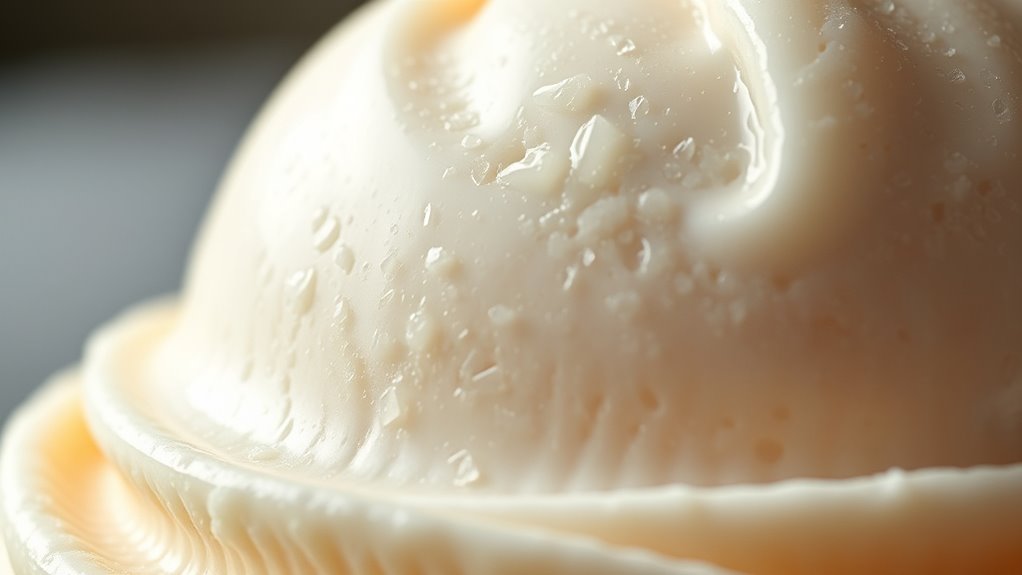
Controlling ice crystal formation is key to getting smooth, creamy ice cream. You can do this by managing nucleation, precise temperature control, and effective agitation during freezing. These factors work together to prevent large crystals and guarantee a velvety texture. Additionally, understanding the dynamic communication exercises for couples can help in sharing feelings about textures and preferences, leading to a more tailored and satisfying ice cream experience.
Nucleation Process Control
Nucleation process control plays a crucial role in determining the ice crystal size within ice cream, directly influencing its smoothness and creaminess. By managing seed nucleation, you can control when and where crystal formation begins. Initiating rapid and uniform nucleation creates numerous small crystals, resulting in a smoother texture. Conversely, slow or uneven nucleation allows larger crystals to grow, causing a gritty mouthfeel. Techniques such as adding nucleating agents or controlling agitation help regulate crystal formation. These methods ensure consistent nucleation sites, preventing unwanted crystal growth. Precise control over the nucleation process is essential for achieving the perfect balance between creaminess and structural stability, ultimately delivering a luxurious ice cream experience. Incorporating yoga techniques such as controlled breathing can also improve precision and consistency in manufacturing processes.
Temperature Management Precision
Precise temperature management is essential for controlling ice crystal growth and guaranteeing a smooth, creamy texture in ice cream. When you keep the temperature just right, tiny ice crystals form, preventing a gritty mouthfeel. This control also impacts flavor infusion; cooler temperatures help lock in flavors without over-diluting or causing separation. Additionally, consistent temperatures influence packaging design, as properly cooled ice cream maintains its shape and prevents melting or frost buildup during storage and transportation. By maintaining ideal temperatures, you ensure your ice cream stays smooth and flavorful from production to consumption. This meticulous temperature regulation is key to delivering that irresistible creaminess you crave while preserving the integrity of the ingredients and overall product quality. Furthermore, understanding the science behind fatherly guidance can inspire food scientists to develop more innovative cooling technologies that enhance product consistency and quality.
Agitation and Mixing Dynamics
Maintaining the right temperature sets the stage for effective agitation and mixing, which are essential for controlling ice crystal size and achieving that signature smoothness. During agitation, vortex turbulence creates dynamic flow patterns that distribute ingredients evenly, preventing large ice crystals from forming. Shear forces generated by mixing break up ice crystals and inhibit their growth, resulting in a creamier texture. Proper agitation ensures constant movement, which promotes uniformity and prevents ice formation on the container walls. Additionally, filter replacement is crucial for maintaining the efficiency of the ice cream machine’s components, ensuring consistent performance over time. By carefully regulating vortex turbulence and shear forces, you help produce an ideal consistency, balancing smoothness with richness. This delicate interplay of forces keeps the ice crystals small and evenly dispersed, delivering that irresistibly creamy mouthfeel that makes your ice cream a true treat.
Mechanical Components: How Ice Cream Machines Operate Behind the Scenes

To understand how ice cream machines work behind the scenes, it’s essential to look at their mechanical components. The motor operation drives the entire process, powering the mixing and freezing functions. When you switch on the machine, the motor activates, transferring power through gear mechanisms that control speed and torque. These gears ensure smooth operation, translating the motor’s rotation into precise movements needed for churning the ice cream mixture. The gear mechanisms also help regulate the pace, preventing overloading or damage. As the motor runs, it spins paddles or agitators within the freezing chamber, evenly incorporating air and preventing ice crystal formation. Gear mechanisms work seamlessly together, transforming raw ingredients into creamy ice cream efficiently and reliably behind the scenes.
Innovations in Ice Cream Technology: Modern Advances and Future Trends
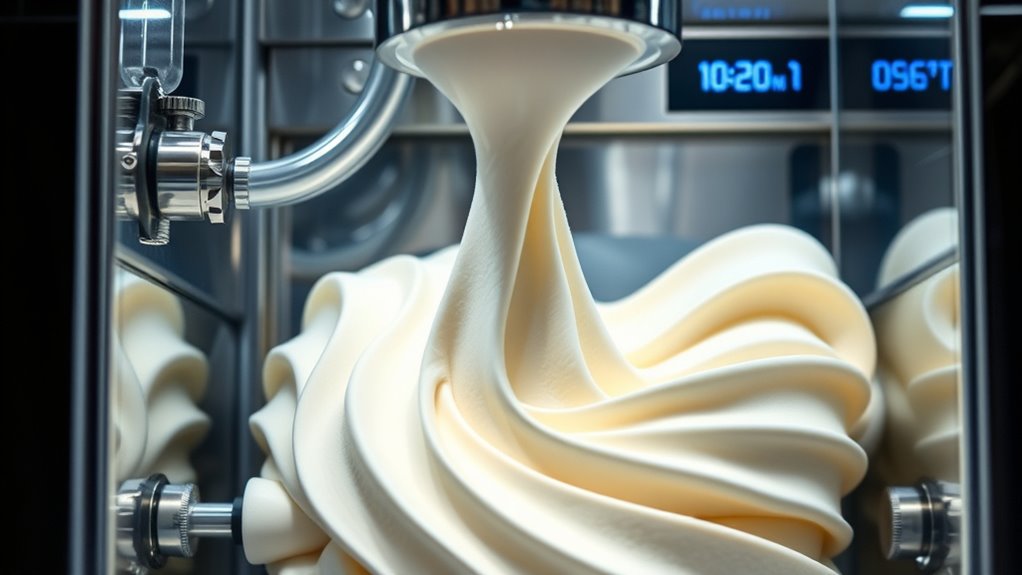
Advancements in ice cream technology are transforming how machines produce your favorite treat, making the process faster, more efficient, and more customizable than ever before. Modern innovations like flavor infusion allow you to enjoy unique, layered tastes, while packaging innovations ensure freshness and convenience. These trends enable manufacturers to quickly adapt to consumer preferences and reduce waste. For example, automated systems now integrate precise temperature controls and rapid freezing techniques, improving texture and quality. Additionally, new packaging designs enhance shelf life and ease of use. The integration of sustainable practices in manufacturing is also gaining importance, promoting eco-friendly solutions throughout the production cycle.
Frequently Asked Questions
How Do Ice Cream Machines Prevent Ice Crystal Formation During Freezing?
You might wonder how ice cream machines prevent ice crystal formation during freezing. They achieve this through precise temperature regulation, keeping the mixture cold enough to freeze smoothly. Additionally, they use ice crystal control techniques, like continuous agitation, to break up forming crystals. This prevents large, unpleasant ice chunks, resulting in a creamy texture. By maintaining ideal conditions, the machine guarantees your ice cream stays smooth and delicious every time.
What Role Does Air Incorporation Play in Ice Cream Texture?
Air incorporation plays a key role in ice cream texture by creating air bubbles that lighten the mixture. These bubbles give your ice cream a smoother, creamier feel while preventing it from becoming too dense or icy. As you enjoy each scoop, you’re experiencing how air enhances the overall texture, making it more enjoyable. Proper air incorporation guarantees a delightful, velvety mouthfeel that keeps your ice cream irresistibly indulgent.
How Do Different Ingredients Affect Freezing Point Depression?
You might notice that adding ingredients like sugar and fats surprisingly lowers the freezing point of your ice cream. When you include sugar, it causes freezing point depression, preventing the mixture from freezing solid, resulting in a smoother texture. Fat emulsification also plays a role by creating tiny fat droplets that interfere with ice crystal formation, making your ice cream softer and creamier. These ingredients work together, often coincidentally, to improve your ice cream experience.
Can Ice Cream Machines Adapt to Various Recipe Formulations Automatically?
You might wonder if ice cream machines can automatically adapt to various recipe formulations. Many modern machines offer impressive machine adaptability, allowing you to tweak ingredients for different flavors and textures. This enhances recipe flexibility, so you don’t need to worry about precise measurements or ingredient changes. These advanced features make it easier to experiment with new recipes, ensuring consistent results regardless of recipe variations, and giving you more creative freedom.
What Are the Most Significant Technological Innovations in Commercial Ice Cream Machines?
Imagine ice cream machines that seamlessly blend flavor customization, boost energy efficiency, and elevate your experience. You see, the most significant innovations include smart controls that automatically adjust mixing and freezing, energy-efficient compressors that reduce power use, and advanced temperature sensors ensuring perfect texture. These innovations work together, making your frozen favorites more personalized, eco-friendly, and consistently delicious with minimal effort—revolutionizing how commercial ice cream machines serve up your favorite treats.
Conclusion
Now that you’ve uncovered the secrets behind ice cream machines, you can see how each part works together like a well-orchestrated symphony. From the chemistry of freezing to the mechanical components, every detail guarantees your favorite treat is perfectly creamy and smooth. Next time you enjoy ice cream, remember it’s like a magic potion, blending science and innovation behind the scenes, making every scoop a delightful masterpiece.
